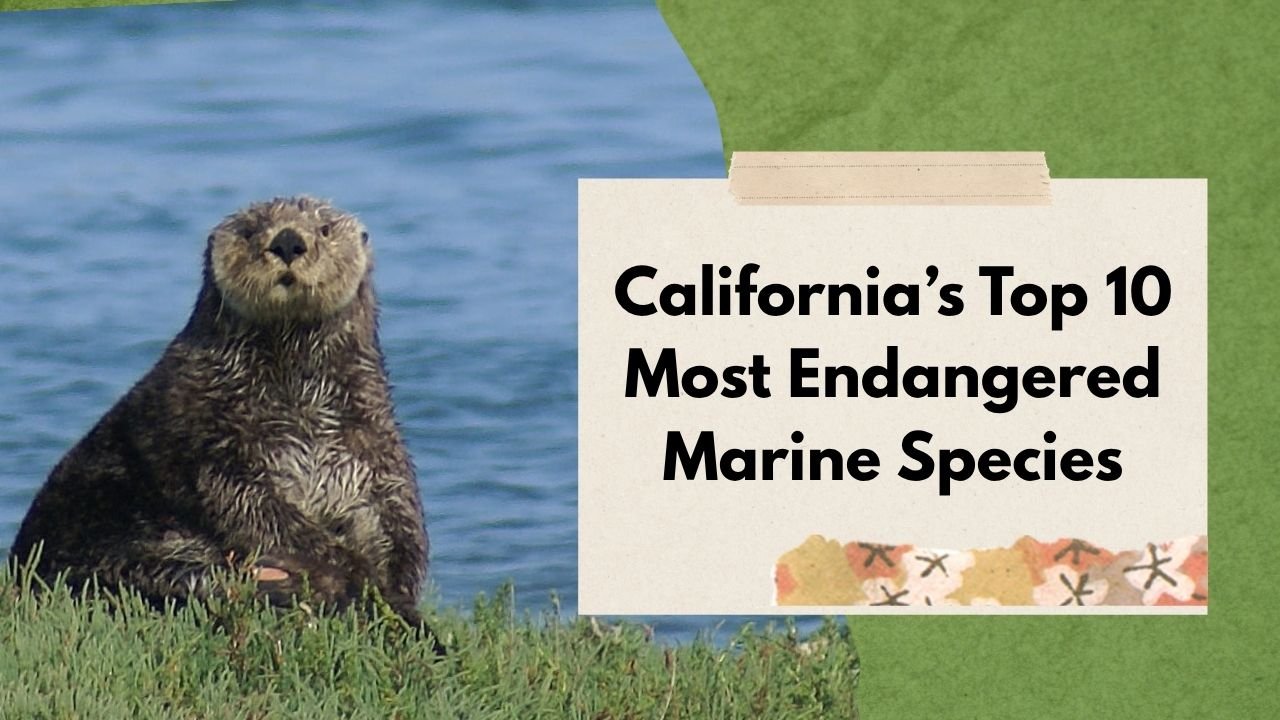California’s coastal and ocean ecosystems are home to a dazzling diversity of marine life. Yet many species that depend on these waters are facing grave threats.
From overfishing and habitat loss to climate change and pollution, endangered marine species off California need immediate attention.
This article delves into the Top 10 Most Endangered Marine Species in California waters, presenting their status, challenges, and significance.
We’ll cover key facts, population trends, threats, and what’s being done—and can still be done—to prevent extinction.
How We Define “Most Endangered”
“Endangered” can refer to species listed under federal or state endangered species acts, or ones that scientists widely recognize as critically imperiled.
The list below is based on known conservation status, ecosystem significance, and visibility in the California Current ecosystem.
Here’s a snapshot:
| Rank | Species | Conservation Status | Key Threats | Approx. Population / Trend |
|---|---|---|---|---|
| 1 | Southern Sea Otter | Endangered | Pollution, disease, predation, food scarcity | A few thousand; slowly recovering but fluctuating |
| 2 | White Abalone | Critically Endangered | Overharvest, disease, habitat loss | Nearly extinct in wild (very few remain) |
| 3 | Central California Coho Salmon | Endangered / threatened | Dams, water diversion, habitat destruction | Declining in many river systems |
| 4 | Delta Smelt | Threatened / Endangered | Water management, habitat loss, pollution | Functionally extinct in many parts of delta |
| 5 | Bocaccio Rockfish | Threatened | Overfishing, bycatch, habitat disruption | Depressed populations, slow recovery |
| 6 | Shortfin Mako Shark | Endangered | Overfishing, bycatch | Globally threatened; local populations under pressure |
| 7 | Scalloped Hammerhead Shark | Critically Endangered | Shark fin trade, habitat loss, bycatch | Very low numbers along Pacific coasts |
| 8 | Blue Whale (California population) | Endangered / recovering | Ship strikes, noise, prey declines | Slowly increasing but still vulnerable |
| 9 | Vaquita (border region) | Critically Endangered | Gillnet fishing, bycatch | Possibly fewer than a dozen remain |
| 10 | Red Abalone | Vulnerable / at risk | Warming oceans, disease, harvesting pressure | Declines in many southern populations |
Detailed Profiles
1. Southern Sea Otter
The sea otter is iconic in California’s kelp forest ecosystems. While protection has allowed some recovery, the population is still vulnerable. Disease, parasites, pollution, and predatory attacks from sharks remain serious threats. The species plays a keystone role by controlling sea urchins and preserving kelp forests.
2. White Abalone
Once common, white abalone has been decimated by overharvesting. Now, very few exist in the wild. Efforts include captive breeding and reintroduction programs, but recovery is slow, and habitat remains degraded.
3. Central California Coho Salmon
This salmon population is one of the southernmost wild coho groups in the U.S., residing in streams north and south of San Francisco Bay. Dams, altered river flows, and habitat damage have caused steep declines. Some populations are already extirpated in certain rivers.
4. Delta Smelt
A small fish endemic to the Sacramento–San Joaquin Delta, delta smelt is often called an indicator species of the estuary’s health. Its once-abundant populations have collapsed due to water diversions, pollution, invasive species, and habitat alteration. Many scientists consider it functionally extinct in large portions of its historic range.
5. Bocaccio Rockfish
Bocaccio is one of the rockfish species hard hit by decades of overfishing and bycatch. They grow slowly, mature late, and produce few offspring, which makes population rebounds difficult. Some juvenile fish use oil platforms near Southern California as surrogate habitat.
6. Shortfin Mako Shark
This fast, pelagic shark is vulnerable to overfishing and bycatch, especially in longline fisheries. While it ranges broadly in the Pacific, the California waters’ population faces pressure from both commercial and recreational fishing.
7. Scalloped Hammerhead Shark
Often targeted for fins and vulnerable to habitat decline, the scalloped hammerhead is in critical danger. Their coastal and nearshore habits bring them into conflict with human activity, further endangering them.
8. Blue Whale (California population)
While blue whales off the California coast have shown signs of recovery in recent years, they remain fragile. Threats include ship collisions, underwater noise, climate-driven changes in prey (krill), and pollution stress.
9. Vaquita
Though not strictly within California waters, the vaquita merits mention due to proximity and shared ecosystem threats. It is perhaps the most endangered marine mammal in the world, with fewer than a dozen individuals believed to remain. Illegal gillnet fishing is its principal threat.
10. Red Abalone
Once widespread, red abalone populations have declined, particularly in southern California. Warmer waters, disease, and illegal harvesting compound the risk. Recovery efforts are underway, but many local stocks remain in poor shape.
Why These Species Matter
These marine species are not just names on a list—they are critical parts of their ecosystems. Sea otters regulate urchin populations and protect kelp forests; rockfish and sharks keep fish populations balanced; salmon help connect marine and freshwater ecosystems; abalones graze kelp surfaces and influence substrate dynamics; whales influence ocean nutrient dynamics.
When these species decline, the balance of the marine environment unravels. Ecosystems become fragile, less resilient, and less capable of supporting fisheries, tourism, and coastal health.
Common Threats Across the List
Several threats recur across these species:
- Overfishing & bycatch: Many species are caught unintentionally or targeted for trade.
- Habitat loss & alteration: Estuaries, kelp forests, deep reefs, and spawning streams are degraded.
- Climate change & ocean warming: Temperature shifts alter food webs, exceed thermal tolerance, and favor disease.
- Pollution & contaminants: Runoff, plastics, pesticides, parasites, and disease agents spread more easily in stressed systems.
- Noise & ship strikes: Especially for whales, vessel collisions and underwater noise disrupt feeding and migration.
Addressing these threats demands coordinated conservation, policy action, habitat restoration, and public support.
Conservation Efforts & Hope
Despite high risk, conservation programs are underway. Captive breeding (for abalones, otters), reintroduction, marine protected areas, fishing bans, habitat restoration, and stricter pollution controls all play a part.
For example:
- Sea otter populations have slowly expanded under protection.
- Rockfish species benefit from fishing restrictions and habitat protections.
- Salmon recovery projects aim to modify dams, restore riparian zones, and improve stream flows.
- Blue whales benefit from shipping lane changes and vessel speed limits.
Each species’ recovery will require long-term commitment and cross-sector collaboration.
California’s marine realm is rich, but its creatures are under siege. From sea otters and abalones to salmon, sharks, and whales, these top 10 endangered marine species face real danger. Yet their stories are not just of loss—they are also of resilience, hope, and possibility.
By understanding their status, appreciating their ecological roles, and supporting thoughtful conservation action, we can help these species thread back from the brink. The ocean’s health—and our own future—depends on it.
FAQs
Which marine species is the most critically endangered near California?
White abalone and vaquita are among the most critically endangered—white abalone almost extinct in the wild, and vaquita numbering only in single digits globally.
Can these endangered species recover?
Yes—many have partial recoveries underway. But recovery is slow, vulnerable to setbacks, and depends heavily on sustained conservation efforts and threat mitigation.
How can individuals help protect these species?
Support marine conservation organizations, advocate for stronger protection laws, reduce plastic and chemical pollution, and choose sustainable seafood options. Public awareness and citizen pressure matter.



